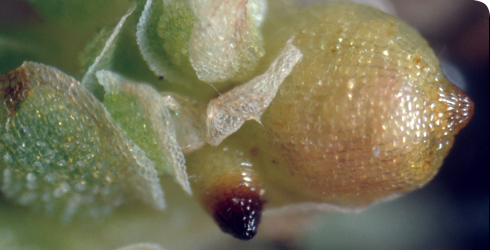Biology
Plants often change colour dramatically in autumn or winter from green to a distinctive deep red colour. The colouration is caused by the production of anthocyanins, a process that is controlled by environmental conditions and/or by stress.
Life cycle
Sexual reproduction
In common with other ferns, Azolla has 2 alternating generations:
- the main sporophyte plant that produces spores
- the insignificant gametophyte on which the sexual organs develop
Azolla is one of the few ferns that are heterosporous - they produce 2 types of spores, large female spores and tiny male spores. These form inside sporangia contained in sporocarps. The sporocarps are able to withstand sub-zero temperatures as well as desiccation, so can help populations to overwinter and survive adverse conditions. However, Azolla does not regularly produce spores in the UK, a process probably influenced by environmental factors.
Females:

Fluorescence image of cross-section of the megaspore apparatus of Azolla mexicana.The megaspore is on the left with part of the spore wall; to the right are two of the triangular floats; on the extreme right is the brown indusium cap below which (seen as red dots) are the cyanobacteria. © H Schneider
- megasporocarps contain 1 megasporangium, inside which a single megaspore develops
- as the megaspore matures, floats develop above it, topped with a colony of cyanobacteria and covered by a dark conical indusium; collectively this is known as the ‘megaspore apparatus’
- at maturity the megasporangium wall disintegrates to reveal the warty spore wall with its tangled hairs
- a female prothallus develops, initially within the megaspore, later protruding
- 1 or more archegonia (female sex organs) form on the prothallus
Males:
- microsporocarps contain numerous microsporangia, each containing 64 microspores
- on maturity the microsporocarp and microsporangia break open to release the microspores, which are clumped together with other tissue in massulae that bear barbed hairs called glochidia
- within the massula prothalli develop in the microspores
- 1 antheridium (the male sex organ) is produced on the prothallus
The massula glochidia get caught in the hairs of a floating megaspore and the combined structure sinks. Fertilisation occurs and the resulting zygote (fertilised egg) develops into a new sporophyte the following spring.
Azolla species are unique in that the cyanobacterium symbiont is transferred from generation to generation via the megasporocarp, rather than the new sporophyte requiring reinfection by the cyanobacterium.
The relationship is mutually beneficial as the cyanobacterium has a niche to live in and the Azolla receives the nitrogen it requires.
Vegetative reproduction
Vegetative propagation in Azolla is extremely efficient. Plants break up very readily at branching points to establish numerous new individuals. If conditions are favourable, Azolla filiculoides can double the area it covers in just 5 to 10 days.
Plants usually die back or sink in winter, though they can overwinter in milder climates. In spring when temperatures rise the plants begin to grow and rise to the surface.
Glossary
Eutrophic
Rich in nutrients.
Glochidia
Barbed hairs on massulae.
Heterosporous
Having 2 kinds of spores.
Indusium
Tissue that protects the sporangia.
Massula
Mass of microspores and associated tissue (term is also applied to female ‘floats’ in the megaspore apparatus).
Megaspore
Female spore.
Microspore
Male spore.
Monophyletic
Descended from a single common ancestor.
Papilla
Minute projection on the surface of a leaf.
Prothallus
Fern gametophyte.
Sporangium
Spore capsule.
Sporocarp
Structure that contains the sporangia.
Symbiont
An organism in a close and long-term association with another species.
